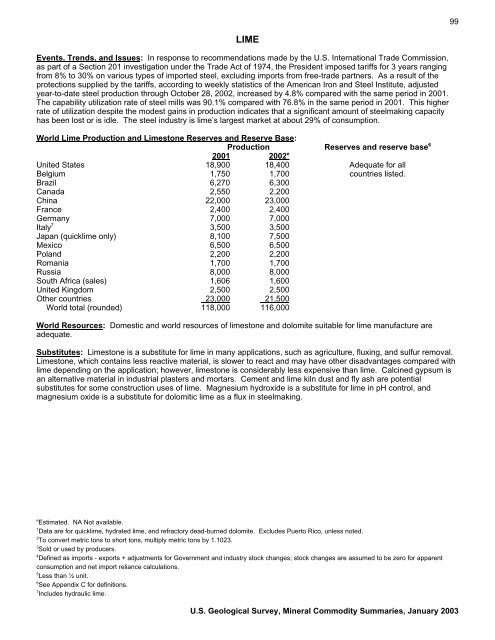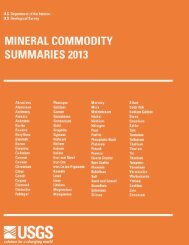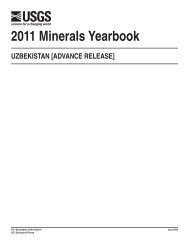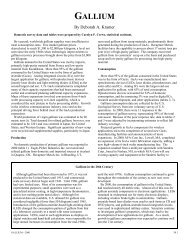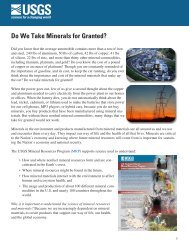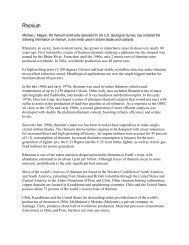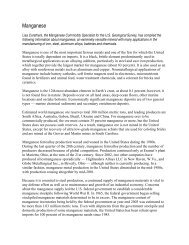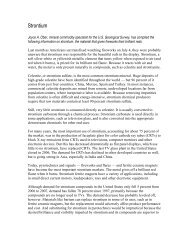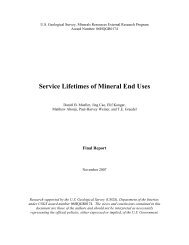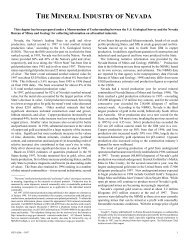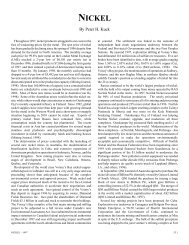Mineral Commodity Summaries 2003 - Mineral Resources Program ...
Mineral Commodity Summaries 2003 - Mineral Resources Program ...
Mineral Commodity Summaries 2003 - Mineral Resources Program ...
Create successful ePaper yourself
Turn your PDF publications into a flip-book with our unique Google optimized e-Paper software.
LIME<br />
Events, Trends, and Issues: In response to recommendations made by the U.S. International Trade Commission,<br />
as part of a Section 201 investigation under the Trade Act of 1974, the President imposed tariffs for 3 years ranging<br />
from 8% to 30% on various types of imported steel, excluding imports from free-trade partners. As a result of the<br />
protections supplied by the tariffs, according to weekly statistics of the American Iron and Steel Institute, adjusted<br />
year-to-date steel production through October 28, 2002, increased by 4.8% compared with the same period in 2001.<br />
The capability utilization rate of steel mills was 90.1% compared with 76.8% in the same period in 2001. This higher<br />
rate of utilization despite the modest gains in production indicates that a significant amount of steelmaking capacity<br />
has been lost or is idle. The steel industry is lime’s largest market at about 29% of consumption.<br />
World Lime Production and Limestone Reserves and Reserve Base:<br />
Production Reserves and reserve base 6<br />
2001 2002 e<br />
United States 18,900 18,400 Adequate for all<br />
Belgium 1,750 1,700 countries listed.<br />
Brazil 6,270 6,300<br />
Canada 2,550 2,200<br />
China 22,000 23,000<br />
France 2,400 2,400<br />
Germany 7,000 7,000<br />
Italy 7<br />
3,500 3,500<br />
Japan (quicklime only) 8,100 7,500<br />
Mexico 6,500 6,500<br />
Poland 2,200 2,200<br />
Romania 1,700 1,700<br />
Russia 8,000 8,000<br />
South Africa (sales) 1,606 1,600<br />
United Kingdom 2,500 2,500<br />
Other countries 23,000 21,500<br />
World total (rounded) 118,000 116,000<br />
World <strong>Resources</strong>: Domestic and world resources of limestone and dolomite suitable for lime manufacture are<br />
adequate.<br />
Substitutes: Limestone is a substitute for lime in many applications, such as agriculture, fluxing, and sulfur removal.<br />
Limestone, which contains less reactive material, is slower to react and may have other disadvantages compared with<br />
lime depending on the application; however, limestone is considerably less expensive than lime. Calcined gypsum is<br />
an alternative material in industrial plasters and mortars. Cement and lime kiln dust and fly ash are potential<br />
substitutes for some construction uses of lime. Magnesium hydroxide is a substitute for lime in pH control, and<br />
magnesium oxide is a substitute for dolomitic lime as a flux in steelmaking.<br />
e<br />
Estimated. NA Not available.<br />
1<br />
Data are for quicklime, hydrated lime, and refractory dead-burned dolomite. Excludes Puerto Rico, unless noted.<br />
2<br />
To convert metric tons to short tons, multiply metric tons by 1.1023.<br />
3<br />
Sold or used by producers.<br />
4<br />
Defined as imports - exports + adjustments for Government and industry stock changes; stock changes are assumed to be zero for apparent<br />
consumption and net import reliance calculations.<br />
5 Less than ½ unit.<br />
6 See Appendix C for definitions.<br />
7 Includes hydraulic lime.<br />
U.S. Geological Survey, <strong>Mineral</strong> <strong>Commodity</strong> <strong>Summaries</strong>, January <strong>2003</strong><br />
99


